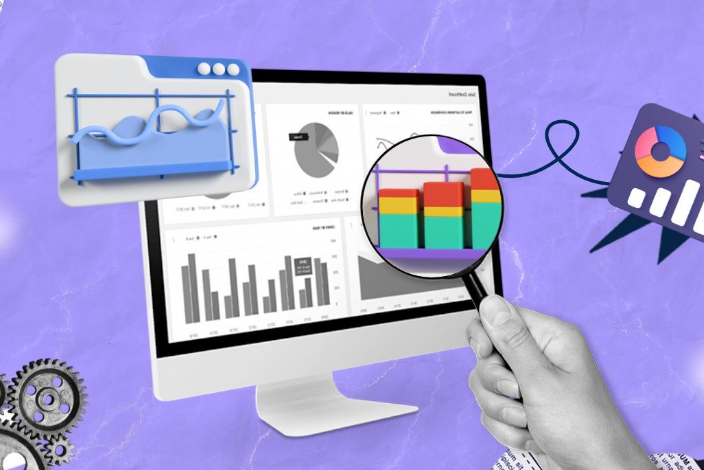How Observability Tools Can Transform Your Business Operations

In today’s fast-paced and highly competitive business landscape, having a clear understanding of how your systems and applications are performing is crucial for success. This is where observability tools come in – they provide insights into the inner workings of your infrastructure, helping you identify and troubleshoot issues before they become major problems. In this section, we will dive deeper into what observability tools are, why they are important, and how they can transform your business operations.
Observability tools refer to a set of software applications that collect and analyze data from various components of your IT infrastructure. These components include servers, databases, code repositories, network devices, cloud services, and more. The purpose of these tools is to provide real-time visibility into the performance of your entire system stack. Through metrics such as response times, error rates, resource utilization, and logs, observability tools give you a complete picture of how each component is functioning individually and about others.
Why are They Important?
Traditionally, businesses have relied on monitoring tools that only capture basic metrics such as CPU usage or disk space. While these metrics are essential for understanding the health of individual components in isolation, they do not provide a holistic view of the system’s overall performance or allow for easy troubleshooting when issues arise. Observability tools fill this gap by providing granular data across all layers of the infrastructure stack. This allows businesses to proactively identify bottlenecks or anomalies before they cause disruptions to their operations.
How Can They Transform Your Business Operations?
The benefits of using observability tools go beyond just improving system performance. By gaining real-time insights into their entire IT environment, businesses can optimize resource allocation and detect potential issues early on. This translates to improved uptime for critical applications and increased productivity for teams who no longer have to spend hours manually sifting through logs trying to pinpoint problems.
Moreover, with modern observability tools, businesses can leverage machine learning and artificial intelligence to analyze large volumes of data and identify patterns that may be causing performance issues. This level of intelligent monitoring enables companies to proactively detect and solve problems before they impact end-users, resulting in a better user experience.
Observability tools play a crucial role in today’s digital landscape. They provide businesses with the necessary visibility and insights to optimize their operations, increase efficiency, and deliver a seamless experience for their customers. In the next section, we will explore some of the top observability tools on the market and how they can benefit your business.
Why Observability is Important for Business Operations?
Observability is crucial for business operations because it provides real-time insights into the entire system. By having visibility into every aspect of your operations, you can quickly identify and address any issues before they escalate. This proactive approach helps in maintaining optimal performance levels and ensures seamless functioning.
Without observability tools, businesses may struggle to pinpoint the root cause of problems, leading to prolonged downtime and decreased productivity. The ability to track metrics, logs, and traces allows for a comprehensive understanding of system behaviour, enabling better decision-making processes.
Moreover, observability promotes transparency within an organization by fostering collaboration between different teams. By sharing data and observations across departments, companies can work towards common goals more effectively. Overall, investing in observability tools is not just beneficial but essential for staying competitive in today’s fast-paced business landscape.
Types of Observability Tools and Their Features;
When it comes to observability tools, there is a wide range of options available for businesses to choose from. Some common types include logging tools, metrics monitoring tools, distributed tracing tools, and real-time analytics platforms. Observability tools are crucial for businesses to proactively monitor and manage their systems, applications, and infrastructure. These tools provide real-time insights into the performance, availability, and health of a company’s digital operations. They help businesses identify and resolve issues quickly, improve efficiency, and deliver a better user experience. However, with the market flooded with various observability tools, it can be overwhelming for organizations to choose the right one.
In this section of our blog article “How Observability Tools Can Transform Your Business Operations”, we will discuss the different types of observability tools available in the market and their key features.
1) Logging Tools:
Logging is the process of recording events or activities that occur within an application or system. Logging tools collect data from various sources such as servers, databases, applications, and network devices in real time. They store this data in a centralized location for easy management and analysis. These tools also allow users to search for specific events using keywords or filters.
2) Monitoring Tools:
Monitoring tools continuously track system metrics such as CPU usage, memory utilization, network traffic, etc., providing real-time visibility into the health of applications and infrastructure components. They send alerts when predefined thresholds are breached so that teams can take action immediately.
3) Tracing Tools:
Tracing is a method used to measure latency between different components of an application or system. Tracing tools capture detailed information about every request made by a user through an application stack. This helps developers identify bottlenecks in performance quickly.
4) APM (Application Performance Management) Tools:
APM Tools provide end-to-end visibility into application performance by monitoring code-level activity inside applications. They help developers pinpoint errors or bugs in code that may be causing issues in production environments.
5) Synthetic Monitoring Tools:
Synthetic monitoring involves simulating user interactions with an application from different locations around the world to determine its availability and responsiveness. Synthetic monitoring tools provide round-the-clock monitoring, thus ensuring that issues are identified even before real users experience them.
6) Infrastructure Monitoring Tools:
Infrastructure monitoring tools keep a check on the health and performance of servers, networks, and other IT infrastructure components. They provide visibility into system metrics such as CPU usage, memory utilization, disk space, etc., making it easier for teams to identify potential problems.
Choosing the right observability tool depends on the specific needs and goals of a business. While some organizations may require all types of observability tools mentioned above, others may only need a few. It is essential to evaluate different options carefully and choose the one that best suits your business requirements. With the right observability tool in place, businesses can gain valuable insights into their operations and make data-driven decisions for improved efficiency and customer satisfaction.
Case Studies: Real-Life Examples of How Businesses Have Utilized Observability Tools
Let’s dive into real-life examples of how businesses have leveraged observability tools to enhance their operations.
A leading e-commerce company utilized observability tools to monitor website performance, quickly identifying and resolving issues before they impact user experience. This proactive approach led to increased customer satisfaction and higher conversion rates.
In the finance sector, a major bank implemented observability tools to gain deep insights into its complex IT infrastructure. By analyzing data in real-time, they were able to detect anomalies and prevent potential security breaches, ensuring robust protection for sensitive financial information. Furthermore, a global tech company used observability tools to optimize resource allocation across multiple cloud environments. By tracking key metrics such as CPU usage and network latency, they achieved cost savings while maintaining optimal system performance.
These case studies highlight the diverse applications of observability tools across various industries, showcasing their transformative impact on business operations.
Benefits of Implementing Observability in Your Business Operations;
Implementing observability tools in your business operations can lead to a myriad of benefits. By gaining real-time insights into your systems and applications, you can proactively identify and resolve issues before they impact your customers. This proactive approach helps improve the overall user experience and enhances customer satisfaction.
Increased visibility across your entire infrastructure allows for better decision-making and resource allocation. With observability, you can optimize performance, streamline processes, and ultimately drive efficiency within your organization. Additionally, the ability to track key metrics and KPIs in real-time enables you to make data-driven decisions that align with your business goals.
Furthermore, implementing observability fosters a culture of collaboration among teams by providing them with a shared understanding of system behavior. This transparency promotes faster problem resolution and encourages innovation within the company. Overall, integrating observability tools into your business operations empowers you to stay ahead of competition and adapt quickly to changing market demands.
Challenges and Considerations for Choosing the Right Observability Tool;
Choosing the right observability tool for your business can be a daunting task. With so many options available in the market, it’s essential to consider your specific needs and requirements before making a decision.
- One of the challenges businesses face is understanding their data infrastructure well enough to determine which observability tools will provide the most value. It’s crucial to assess factors such as scalability, compatibility with existing systems, and ease of integration.
- Additionally, cost is often a significant consideration when selecting an observability tool. While investing in high-quality software is important, it’s essential to find a solution that fits within your budget and offers a good return on investment.
- Another key aspect to consider is the level of expertise required to implement and maintain the observability tool. Ensuring that your team has the necessary skills and training can help avoid potential issues down the line.
In conclusion, thorough research and careful evaluation are vital when choosing an observability tool that will truly benefit your business operations in the long run.
Tips for Successfully Implementing and Utilizing Observability Tools in Your Business;
When it comes to successfully implementing observability tools in your business, start by clearly defining your goals and objectives. Understanding what you want to achieve will guide you in selecting the right tools for your specific needs.Implementing and utilizing observability tools can greatly benefit your business operations by providing real-time insights into the performance and health of your systems. However, for these tools to be effective, they need to be properly implemented and utilized. In this section, we will discuss some tips for successfully implementing and utilizing observability tools in your business.
1. Define Your Objectives:
Before investing in any observability tool, it is important to define your objectives clearly. What are the specific areas you want to monitor? What metrics are most important for your business? Having a clear understanding of your goals will help you choose the right tool that meets your requirements.
2. Choose the Right Tool:
There are various types of observability tools available in the market, each with its own unique features and capabilities. It is important to carefully evaluate different options before making a decision. Consider factors such as data collection methods, integration with existing systems, ease of use, and pricing when choosing the right tool for your business.
3. Ensure Proper Data Collection:
Observability tools rely on accurate data to provide meaningful insights. Therefore, it is crucial to ensure proper data collection from all relevant sources within your system. This may require setting up agents or instrumentation in different parts of your infrastructure to collect data at various levels.
4. Develop Custom Dashboards:
Most observability tools offer customizable dashboards that allow you to visualize data in a way that is most relevant to your business operations. Take advantage of this feature by creating custom dashboards tailored to specific teams or departments within your organization.
5. Use Alerts Effectively:
Alerts play a critical role in identifying potential issues before they turn into major problems that can affect business operations. However, too many unnecessary alerts can lead to alert fatigue and reduce their effectiveness. It is important to configure alerts based on well-defined thresholds and prioritize them according to their impact on critical systems.
6. Regularly Review Performance Metrics:
Observability tools provide real-time insights, but it is important to regularly review performance metrics over a period of time to identify any trends or patterns. This will help you proactively address potential issues before they impact your business operations.
By following these tips, you can successfully implement and utilize observability tools in your business to transform your operations and drive better outcomes. Remember that observability is an ongoing process and requires constant monitoring and adjustment to stay effective. With the right approach, observability tools can be a game-changer for your business.
Conclusion:
The future of observability in business operations is promising, with advancements in technology enabling even more sophisticated monitoring and analysis capabilities. As organizations strive to stay competitive and agile, investing in robust observability tools will be essential for staying ahead of the curve. Embracing a culture of observability not only allows businesses to react swiftly to changes but also empowers them to innovate and deliver exceptional customer experiences.
By leveraging the full potential of observability tools, businesses can unlock new opportunities for growth and success in today’s dynamic marketplace. Incorporating observability into your business operations is not just a trend – it’s a strategic imperative that can revolutionize how you operate and thrive in the digital age. So seize this opportunity to transform your business operations with observability tools and pave the way for a brighter future ahead.




